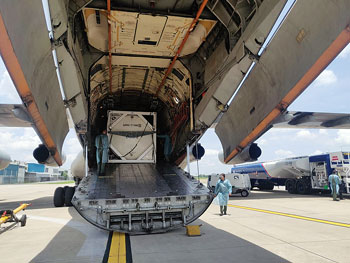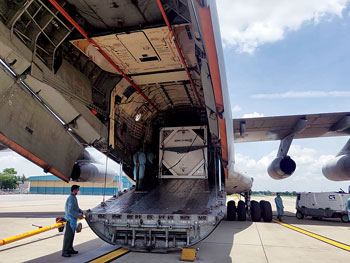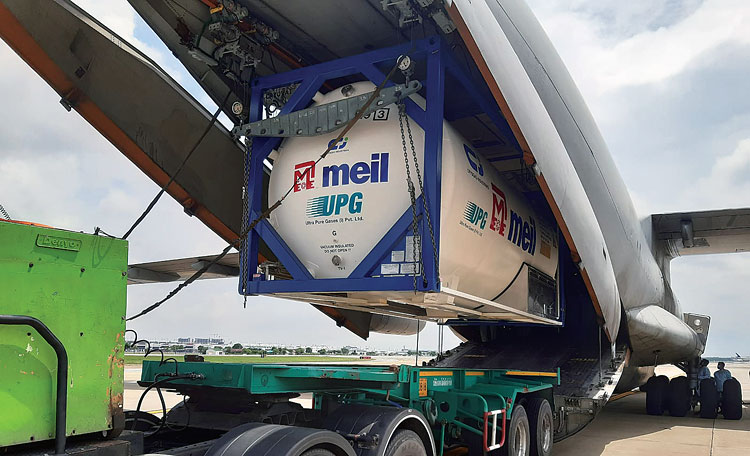INDIAN ARMED FORCES CHIEFS ON OUR RELENTLESS AND FOCUSED PUBLISHING EFFORTS

The insightful articles, inspiring narrations and analytical perspectives presented by the Editorial Team, establish an alluring connect with the reader. My compliments and best wishes to SP Guide Publications.

"Over the past 60 years, the growth of SP Guide Publications has mirrored the rising stature of Indian Navy. Its well-researched and informative magazines on Defence and Aerospace sector have served to shape an educated opinion of our military personnel, policy makers and the public alike. I wish SP's Publication team continued success, fair winds and following seas in all future endeavour!"

Since, its inception in 1964, SP Guide Publications has consistently demonstrated commitment to high-quality journalism in the aerospace and defence sectors, earning a well-deserved reputation as Asia's largest media house in this domain. I wish SP Guide Publications continued success in its pursuit of excellence.
Indian Armed Forces Support the Covid-19 Mitigation Efforts
The Armed Forces are not just providing support to the civil administration and state governments in fighting the current pandemic but are also playing a pivotal role in conducting the Government’s vaccination drive across the country

Indian Armed Forces have been an integral part of the National effort towards mitigating the effect of Covid-19 since last year. As resources and manpower were mobilised to strengthen the set up of field hospitals and ensure effective coordination amongst Services and civil administration, IAF transport aircraft and helicopters undertook operations for speedy air transportation of covid samples, medicines and essential aid to various parts of the country. The evacuation of Indian citizens from Wuhan and Iran were amongst the first missions undertaken by IAF aircraft in the first wave of the pandemic.
CONDUCT OF OPERATIONS- MEDICAL SUPPORT AND AIR EFFORT
As the country battles Covid-19 in 2021, the Armed Forces as part of their operational response, have synergised individual service efforts towards a composite National response. The training of the Armed Forces has been brought to fore effectively bridging gaps, allowing civil authorities to standardise pandemic response solutions across states.


(Above) IL-76 of IAF, landed at Panagarh from Bangkok.
DRDO run Covid hospitals set up exclusively for civilians at Delhi, Ahmedabad, Bihta, Lucknow and Varanasi are manned by the medical personnel of the Army, Navy and the Air Force. Each of these hospitals provides clinical management to moderate and severe cases of Covid pneumonia and are equipped with necessary medical equipment including ventilators and essential ancillary services. 78 Medical Officers, 37 Nursing Officers and 73 Medical Assistants of IAF are working in four DRDO hospitals at Delhi, Ahmedabad, Bihta and Lucknow.
Within the Indian Air Force, Covid care infrastructure has been beefed up in Command and Air Force Hospitals. Doctors and paramedics have been redeployed from less affected places to areas which have a high case load. While providing medical care for IAF personnel and their families, veterans and their family members are also being attended to at various regional and local facilities. Wherever spare capacities are available, doctors and paramedics are being deployed in aid of civil population. Facilities have been created at certain locations for Covid care which are manned by IAF doctors and paramedics to provide necessary succour to the local population. For example, a 100 beds facility, entirely staffed by Air Force medical personnel, is functional at Bengaluru, with admissions being coordinated by the Karnataka government. In addition, a 100 beds Covid care and recuperation facility has been recently set up in collaboration with a civil organisation, M3M foundation at Gurugram.
Towards supporting the set up and sustenance of medical infrastructure across the country, IAF has made available maximum platforms, heavy and medium lift transport aircraft as well as helicopters, for Covid-19 mitigation tasks on a 24x7 basis. 42 transport aircraft have been earmarked which include:
- 12 heavy lift aircraft i.e.,
– C-17 & IL-76 and - 30 medium lift aircraft, i.e.,
– C-130 and An-32s
In addition, helicopters have been deployed wherever required. A major part of the operations this year comprises airlift of cryogenic oxygen containers from abroad and transportation within the country. This has resulted in capacity enhancement and also in drastically reducing the transportation time for empty oxygen containers to reach the recharging facilities. The IAF has flown C-17 and IL-76 aircraft to 13 countries in this effort (Singapore, Thailand, Indonesia, UAE, Kuwait, Qatar, France, Germany, UK, Belgium, Australia, Netherlands, and Israel). The transportation of oxygen tankers within the country is being undertaken on a daily basis with an average of 10 to 11 aircraft ferrying the tankers to recharging facilities at Jamnagar, Panagarh, Ranchi and Bhubaneswar.
Since 15 May, IAF aircraft are airlifting empty oxygen containers from the country to countries abroad for recharging and subsequent return by sea, setting up an Air-Sea logistics supply chain which will make medical oxygen available in reduced timelines. IAF aircraft have airlifted more than 120 oxygen containers from abroad and about 670 cryogenic oxygen tankers have been transported within the country. If the available medical oxygen were to be put into a measurable perspective, a single oxygen container of 20 MT capacity makes available 2,449 medical cylinders supporting about 1,200 oxygen beds on a 24 hour cycle. Additionally, air-lift of oxygen concentrators, ventilators, raw material for oxygen plants, oxygen generators, essential medicines and medical personnel for set up of Covid facilities and hospitals is an essential part of these missions and is being centrally coordinated from Air HQ.
IAF has been operating a Covid Air Support Management Cell (CASMC) that has transported more than 700 T of load and coordinated over 400 sorties to various parts of the country
The IAF has so far flown more than 1,500 sorties, transporting close to 14,000 T of load in about 3,000 hours towards Covid mitigation tasks. The total Air miles flown have recently crossed the two million kms mark, which could be equivalent to going around the globe 55 times.
Since April 27, 2021, IAF has been operating a Covid Air Support Management Cell (CASMC) at Air Force Station Palam to efficiently coordinate speedy distribution of Covid medical aid coming from various agencies. The cell is operational round the clock and coordinates resources which include manpower, ground handling and loading equipment to cater for surge operations. The cell maintains communication links with important stakeholders like Ministry of Health and Family Welfare, Ministry of Defence and Indian Red Cross Society for seamless flow of information and to reduce time delays. Customs and Warehousing issues are being coordinated with Delhi International Airport and Air India. Till date CASMC has transported more than 700 T of load and coordinated over 400 sorties to various parts of the country.
Optimisation of Efforts
All assigned tasks are being undertaken in the ‘mission mode’. The entire effort has been optimised by centralised planning and decentralised execution by following the ‘Hub and Spoke’ model. This ensures that aircraft are able to effect a quick turnaround and need not come back to the parent base to undertake their next mission. Mission accomplishments being the focus, efforts are made to ensure that our training and experience in IAF is put into practice in these challenging times. By gainfully utilising all available resources and supporting each other at all times, the desired work output is being ensured.

Since the beginning of the Covid surge, aircrew and technicians across the board have been augmented. The medical, administrative and logistics chain have been activated with personnel working in tandem to facilitate efficient transfer and receipt of essentials and ensure that maximum numbers of personnel are available to undertake operations. Those out of active branch duties due to courses or posting to staff appointments have been given quick refreshers to get back into their job. Internally adequate preventive measures are being taken like vaccination, strict Covid-19 protocols and segregation of crew earmarked for operations.
IAF is also ensuring that as personnel work into extended hours they are protected at all times, and the crew is able to maintain a bio bubble, both at and off base. Proper supervision is being ensured at all levels. Night stay of aircraft at outstations has been minimised to avoid exposure. All personnel have been adequately educated about following Covid appropriate behaviour and crew advised to use PPE. The crew has been advised to stay connected with their families to ensure that even as they stay away; they remain in touch and are available for mutual support.
CONCLUSION
The Indian Air Force remains focused to ensure that maximum platforms and personnel are available to continue effective contribution in the national effort to combat the Covid-19 pandemic.





